‘The idea that new is better isn’t always the case, and is certainly not better for the planet’For Central Otago winemakers Grant Taylor and Jen Parr, sustainability means using secondhand equipment, a Perspex shield around their basket press, natural light, a bicycle and sheep. Grant says he also recycles jokes.
For me, their use of secondhand equipment is particularly interesting as they are using it to create first-class wines. At IWC 2021, their Valli Wines’ Pinot Noir Gibbston Vineyard 2019 was awarded the New Zealand Red Trophy, the Sustainable Trophy and the Central Otago Pinot Noir Trophy, scoring 96/100 along the way.
Grant, one of the most respected winemakers in New Zealand, says 80% of their winery equipment was purchased secondhand. “It’s not because we can’t afford new equipment but because there is perfectly good equipment available,” he explains. “The idea that ‘new is better’ isn’t always the case and is certainly not better for the planet.”
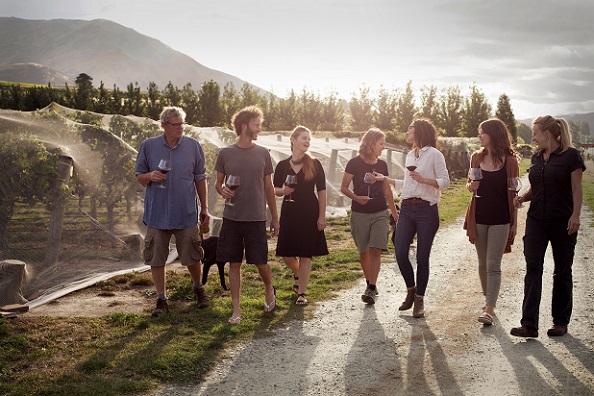
He says they haven’t jumped on the sustainability bandwagon – “although this is a necessary bandwagon to be on” – their desire for sustainability comes from their upbringing. “My grandparents had a big part to play in my upbringing,” he says. “Living through World War 2 with ration books and almost less than they needed, the mantra at home was ‘waste not want not’. Nothing was wasted. One didn’t go out and buy a new whatever, you fixed the old one again and again.”
It’s what they do with their vineyard and winery equipment. It’s why they have old, secondhand presses which they can repair themselves. Referring to the old Wilmes press that looks similar to one Grant first used when he started winemaking in 1980, he points out: “It has survived 40 years and I don’t see why it can’t last another 40 and continue to do a superb job. Something goes wrong, you repair it. Put a new breaker in if a fuse blows, weld where the metal wears, grind out and repaint if it rusts…
“If a more modern press breaks down, I am lost. You need to call the ‘expert’ who comes with a computer program, expensive parts and a big hourly rate.”
He adds: “There is also a sense of pleasure I have yet to define, in taking something someone else has no use for or thinks has no potential and making use of it.”
At Valli, most of the sustainable measures make sense from an economic point of view, too.
“If I do something to save the planet it also saves me dollars,” Grant reflects. “If we focused on saving dollars, the planet would be in a lot better shape.”
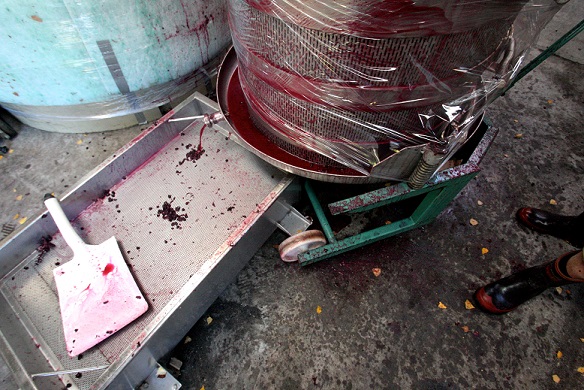
Sustainable measures at Valli Wines
Winery
- They have developed a reusable alternative to the single-use shrink-wrap plastic they used to use during pressing (above). They had a local company make a Perspex jacket for this Italian-made Mori basket press, which is liable to squirt wine out of the slots in the cage unless it’s covered or wrapped.
- They process the fruit within the region (so it’s not trucked across the country).
- No “energy-draining systems” are used in the winery to alter the visual appearance of the wine when there is no qualitative gain. So, there is no unnecessary heating, cooling, cold stabilisation, or filtering.
- Recycling and saving water are important. They now combine daily cleaning jobs to minimise water usage, only cleaning what is necessary and work in parts of the winery to enable combined cleaning jobs.
- Natural light is used most of the time.
- A winery bike is available for journeys between the bottling hall and winery.
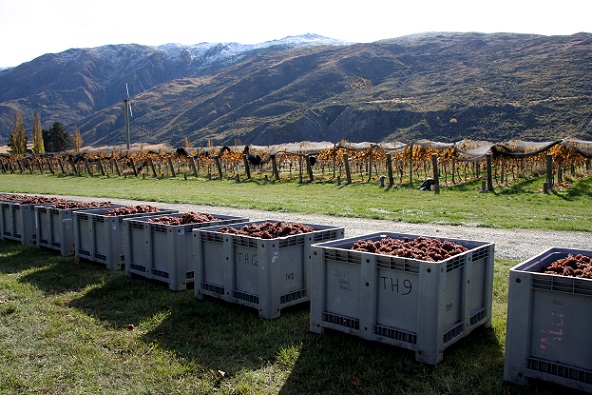
Vineyard
- A container has been reused for the vineyard shed.
- They repair and regularly maintain equipment to ensure longevity.
- They use secondhand equipment and an equipment share scheme. (“Neighbour owns, we borrow and vice-versa,” Grant explains.)
- Sheep grazing instead of mowing when possible.
- They invest in people, not machines – minimising machine use where possible, tending vines by hand from pruning to harvesting.
- After pruning, canes are mulched and go back into the ground to decompose.
- Reuse disposable/biodegradable clips.
- They are germinating their own trees and flowers to plant on the estate.
- They recycle plastic containers.
- They use a weed mat where practical.
Packaging, sales, administration
- The office is powered by solar energy.
- Biodegradable cleaning products are used at head office and in the winery.
- The directors’ quarters and office are a restored sheering shed (from when the property was a sheep farm). Recycled materials were used in the renovation.
- Staff work remotely when possible – cutting down on travel and CO2 emissions as well as saving time.
- They avoid superfluous marketing materials: email signup, promotional materials that are either made reusable or done via a secondhand iPad. Price lists and other materials are emailed unless a hard copy is requested.
- Their mantra is: “We sell wine, not packaging”. They use NZ-produced lightweight glass bottles and screwcaps, both of which are recyclable. They also donate screwcaps to the local Lions Club which recycles them to raise funds for the Kidney Kids NZ charity.
- They are mostly paperless and reuse the backside of paper for notes.

Grant (above) has been crafting wines in Otago since 1993 – when there were only 20ha of vines planted. Now there are more than 2,000ha.
After making wine in the USA, Australia, France, and New Zealand, Grant returned home to Otago and became the winemaker at Gibbston Valley Wines. He went on to make the first wines for many of the region’s well-known labels including Mt Difficulty, Felton Road, Carrick, Peregrine, Mount Edward, Hawkshead, Mondillo, Bald Hills, and Rockburn.
He set up his own label in 1998, naming the business after his great-great-grandfather, Giuseppe Valli, who emigrated to New Zealand from an Italian winemaking background. Grant left Gibbston Valley to focus on his own project in 2006.
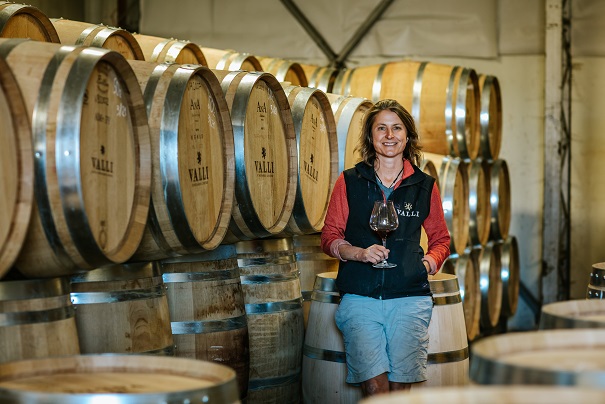
Oregon-born winemaker Jen Parr (above), who has also made wine in the USA, France, South Africa and Australia, joined him from Otago winery Olssens (now Terra Sancta) in 2015.
Their stated aim is “to create wines with honesty, integrity and, most importantly, a sense of place.” For them that means subregional plots such as Bannockburn and Bendigo in Central Otago, and the Waitaki Valley in North Otago.
The Pinot Noir that scooped all the awards at the International Wine Challenge this year came from Gibbston, the coolest and highest of the Central Otago regions.
“These are the most delicate Pinots in Central Otago,” the judges noted.
This understated, graceful and complex Gibbston Pinot Noir comes from a variety of clones (777, 115, UCD 5, 114, 10/5, UCD 6, 113), which are handpicked at optimal ripeness. But Jen admits: “Our definition of optimal is changing.”
A quarter is whole-bunch pressed. The wine is matured for 11 months in French oak barriques from François Frères, Ana Selection and Billon (30% new) before bottling without fining or filtration.
‘We embrace each season as if it is a new friend’Jen outlines some of the sustainable measures used in the production of this wine:
“We wrap the fermenters in wool which provides insulation. Our climate is relatively cool and the grapes usually come in at a nice and cool ambient temperature (under 12°C) so the pre-soak lasts about 5-7 days at ambient temperature with no cooling or heating.
“Our winters are usually very cold so the wines naturally cold stabilise in barrel. When we have a milder winter, sometimes they do not cold stabilise completely and occasionally a harmless tartrate sediment can occur.
“Our Pinots, orange wine and Chardonnay are all wines that ferment to dry and complete a full malolactic fermentation so there is rarely a need to filter. We haven’t filtered our Chardonnay for the last three vintages, but we did the previous two because it didn’t complete ML and we were happy with the balance but not comfortable leaving it unfiltered.
“I mention this because we don’t have an ideology of ‘always’ or ‘never’. Our goal is to make the best possible wines we can each season with as little intervention as possible. We define ‘best’ in this respect as creating wines that genuinely express a specific place in a specific season. We have experience with our sites and with a variety of types of vintages but each year we start with a clean slate and embrace each season as if it is a new friend.”
‘There is more than one right way to do something’The orange wine she mentions is The Real McCoy, a Pinot Gris that comes from their love of experimenting and learning.
“We never get tired of learning and try each season to experiment with a few ferments,” Jen says. “Creating the Real McCoy orange wine back in 2015 was an experiment in its own right. We started cautiously and have built upon our experience each vintage, embracing seasonality each year. With this wine, we have done clonal experiments, whole cluster experiments, stirring experiments, time on skins experiments, tried different vessels, and lees experiments, to name a few.
“With Pinot Noir, we think a lot about how we ferment and the use of whole clusters in particular. We are increasingly using higher percentages of whole clusters (up to 100%) and we have experimented with cap management techniques, pressing decisions and oak toast. We have an experiment this year – which we have done before but are taking more seriously this time – around placement of whole cluster (bottom vs middle). One year we kept our own-rooted 777 separate from the 777 on rootstock to see how the wines differed – and they do!
“We do a lot of trials with barrels, mostly toasts and styles within coopers we know work for our sites and approach. We are quite comfortable with our approach to making wine and are not looking for dramatic shifts but are always keen to learn and see if there is a different way to arrive at our desired goal. When you have seasonal variability like we do, you can’t stand still. The most important thing Grant taught me is that there is more than one right way to do something and just because someone does it differently doesn’t mean it isn’t also ‘right’.”
‘We all need to find our own truth in winemaking’She continues: “Following on from the lesson I learned from Grant, I think we all need to find our own truth in winemaking. For me, authentic wine is wine that is made with intention. You don’t just stumble into a strategy, or solution – you are thinking (with an open mind) every step of the way. I spend more time thinking about what we won’t do than what we will do. Personally, when I taste a new wine, I don’t think about the ‘tag’ or label (lo-fi, natural, blah blah) – I approach it with an open mind and if I can see the winemaking team’s intention (be it simple or lofty), I enjoy the wine.
“When you are making wines that express a place in a season, you must tread very lightly. I am overwhelmingly humbled by the power of a winemaker’s indecision or decisions and I try very hard not to leave a footprint. A painting might have a small signature at the bottom but usually it is very hard to see and that is how I like to think about wine. There is no such thing (for me) as a ‘Grant Taylor’ or a ‘Jen Parr’ wine – that would be a self-portrait and neither of us have those on our walls. If people can see Gibbston in the glass and, even better, Valli Gibbston in a glass and perhaps note that it feels like it came from a warmer or cooler season – that defines successful winemaking for me. So, what works with Pinot Noir and Pinot Gris is understanding the place, the season and the intention.
“You absolutely must understand all of these things to make exceptional wine. There is no one thing that works. Each site is different and each team’s relationship with that site is unique. Just because your neighbour does one thing to manage tannin in Bendigo doesn’t mean it will work for you or vice-versa. But we can both be right if we understand our place.”
The skin-fermented Pinot Gris for The Real McCoy also comes from the Gibbston Vineyard. It’s the wine, they believe, most obviously expresses seasonality.
The winemaking for 2020 features:
- 60% Sel Ovaille clone, 40% Berrysmith
- 17% whole clusters (“due to the small bunches and high acidity”)
- Fermentation in 2,500L open-top fermenter
- MLF
- 11 months in five-year-old Pinot Noir barrels
- Bottled without fining or filtering
The photos of Grant and Jen are by Anna Allan.


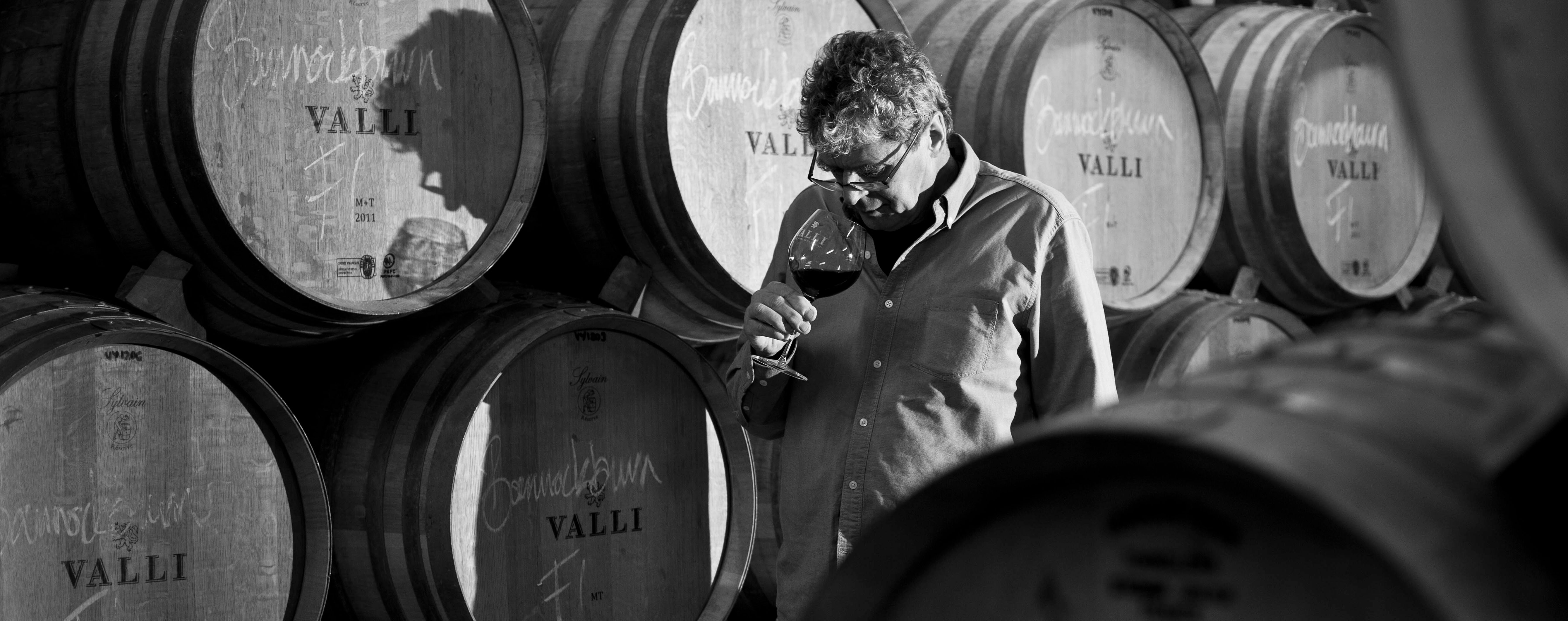










.png)






